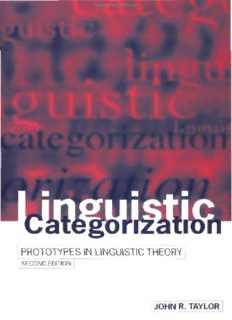Table Of ContentI
PROTOTYPES IN LINGUISTIC THEORY
SECOND EDITION
JOHN R. TAYLOR
LINGUISTIC CATEGORIZATION
LINGUISTIC
CATEGORIZATION
Prototypes in Linguistic Theory
JOHN R. TAYLOR
Second Edition
CLARENDON PRESS • OXFORD
1995
Oxford University Press, Walton Street, Oxford 0x2 6DP
Oxford New York
Athens Auckland Bangkok Bombay Calcutta ('ape Town
Dar n Salaam Delhi Florence I long Kong Istanbul Karachi
Kuala Lumpur Madras Madrid Melbourne Mexico City Nairobi
Paris Singapore Taipei Tokyo Toronto
and associated companies in
Berlin Ibadan
Oxford is a trade mark of Oxford University Press
Published in the United States
by Oxford University Press Inc., Sen1 York
©John R.Taylor 1989, 1995
First published 1989 First published in paperback 1991
Second Edition 1995
All rights reserved. No part of this publication may be reproduced, stored in a
retrieval system, or transmitted, in any form or by any means, without the prior
permission in writing of Oxford University Press. Within the UK, exceptions
are allowed in respect of any fair dealing for the purpose of research or private
study, or criticism or review, as permitted under the Copyright, Designs and
Patents Act, 1988, or in the case of reprographic reproduction in accordance
with the terms of the licences issued by the Copyright Licensing Agency.
Enquiries concerning reproduction outside these terms and in other countries
should be sent to the Rights Department, Oxford University Press, at the
address above.
This book is sold subject to the condition that it shall not, by way of trade or
otherwise, be lent, re-sold, hired out or otherwise circulated without the
publisher's prior consent in any form ofbinding or cover other than that in
which it is published and without a similar condition including this condition
being imposed on the subsequent purchaser
British Library Cataloguing in Publication Data
Data available
Library* of Congress Cataloging in Publication Data
Linguistic categorisation : prototypes in linguistic theory
JohnR. Taylor. - 2nd [enl.f ed.
I. Categorisation (Linguistics) 2. Linguistic analysis
(Linguistics) 3. Cognitive grammar. 4. Semantics. I. Title.
PI28.C37T38 1995 40l\43-dc20 95-19066
ISBN 0-19-870012-1 (Pbk)
ISBN 0-19-870013-X
I 3579108642
Typeset by Joshua Associates Limited, Oxford
Primed in Great Britain on acid-free paper by
Bookcraft (Bath) Ltd., MidsomerNorton
For
GeniaandAry
Preface to the Second Edition
FOR the second edition of this book, I have added an extra chapter,
Chapter 14, which updates the treatment, especially of issues in lexical
semantics. The focus on word meanings reflects a personal interest,
but also the belief that a good deal of a person's knowledge of a
language resides, precisely, in the knowledge of words, and of their
properties. I am grateful, as always, to the many individuals who have
encouraged me in my work, including Dirk Geeraerts, Brygida
Rudzka-Ostyn, Savas Tsohatzidis, Rob MacLaury, and especially
Rene Dirven. My intellectual debt to Ronald Langacker will be
apparent throughout. A special word of thanks, also, to my editor at
Oxford University Press, Frances Morphy, who first suggested the
expanded second edition. I regret that, because of my translation to the
other side of the globe, she had to wait a little longer than promised for
the delivery of the additional chapter.
J.R.T.
Preface to the First Edition
THE title of this book is intentionally ambiguous. In one of its senses,
'linguistic categorization' refers to the process by which people, in
using language, necessarily categorize the world around them. When
ever we use the word dog to refer to two different animals, or describe
two different colour sensations by the same word, e.g. red, we are
undertaking acts of categorization. Although different, the two entities
are regarded in each case as the same.
Categorization is fundamental to all higher cognitive activity. Yet
the seeing of sameness in difference raises deep philosophical
problems. One extreme position, that of nominalism, claims that same
ness is merely a matter of linguistic convention; the range of entities
which may be called dogs, or the set of colours that may be described
as red, have in reality nothing in common but their name. An equally
extreme position is that of realism. Realism claims that categories like
DOG and RED exist independently of language and its users, and that the
words dog and red merely name these pre-existing categories. An
alternative position is conceptualism. Conceptualism postulates that a
word and the range of entities to which it may refer are mediated by a
mental entity, i.e. a concept. It is in virtue of a speaker's knowledge of
the concepts "dog" and "red", i.e. in virtue of his knowledge of the
meanings of the words dog and red, that he is able to categorize
different entities as dogs, different colours as red, and so on. Con
ceptualism may be given a nominalist or a realist orientation. On the
one hand, we can claim that concepts merely reflect linguistic
convention. The English speaker's concepts "red" and "dog" arise
through his observation of how the words red and dog are con
ventionally used; once formed, the concepts will govern future
linguistic performance. Alternatively, we might claim that concepts
mirror really existing properties of the world. On this view, our
concepts are not arbitrary creations of language, but constitute part of
our understanding of what the world is 'really' like. This book will take
a course which is intermediate between these two positions, yet strictly
speaking consonant with neither. To the extent that a language is a
conventionalized symbolic system, it is indeed the case that a language
imposes a set of categories on its users. Conventionalized, however,
does not necessarily imply arbitrary. The categories encoded in a
Description:This book explores the far-reaching implications of Eleanor Rosch's seminal work on categorization and prototype theory, extending the application of prototype theory from lexical semantics to morphology, syntax, and phonology. Providing a clear and readable introduction to the field of cognitive li

